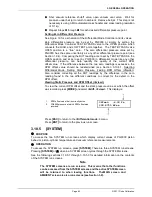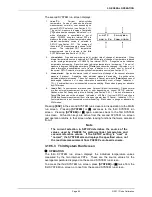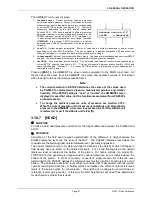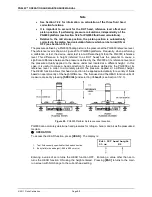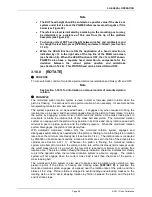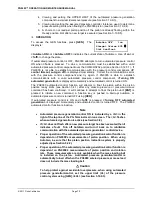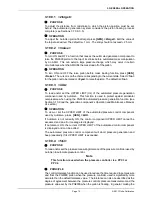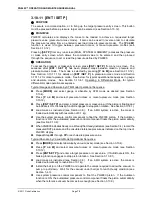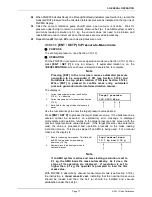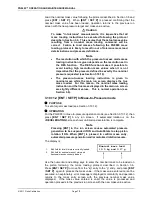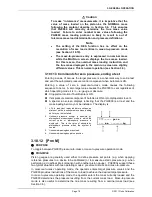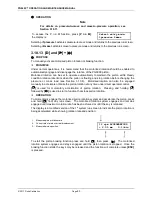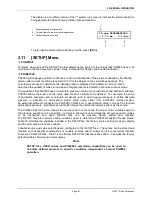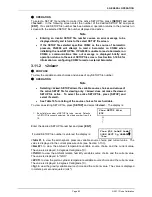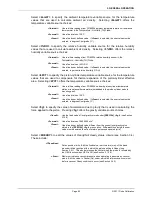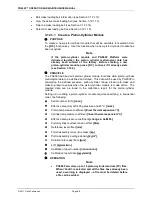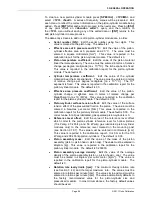
Page 75
© 2011 Fluke Calibration
PRINCIPLE
PG9000 piston-cylinders are sized such that there is a whole number, nominal relationship
between mass loaded on the piston in kilograms [kg] and the pressure at which the piston will
float in kilo Pascal [kPa] or Mega Pascal [MPa]. This relationship is called the
pressure-to-
mass conversion coefficient
and is expressed as kPa/kg or MPa/kg. The
pressure-to-mass
conversion coefficient
is marked on the cap of each piston.
PG9000 mass sets are made up of masses in multiples and submultiples of the kilogram
making it simple to load mass values rounded to 0.01 g, 1 g, 10 g or 0.1 kg.
When using PG9000 to define pressure, the desired pressure value is entered and PG9000
prompts the user with the mass value to be loaded. Due to the many variables that influence the
pressure-to-mass relationship for a piston-cylinder the mass value to load to reach exactly the
pressure requested is not a nominal mass value. Therefore, defining the exact pressure value
requested always requires loading mass with 0.01 g resolution.
When it is acceptable for the pressure values defined to not be the exact the nominal pressure
value, then the operation can be simplified and mass loading errors can be reduced by loading
mass with a lower level of resolution and using the pressure that the lower level resolution mass
load generates. For example, on a piston-cylinder with a nominal pressure-to-mass relationship
of 10 kPa/kg, defining a pressure of exactly 100 kPa, nominally requires loading 10 kg of mass.
However, once all the influences on the measurement are taken into consideration, the actual
mass to load to define exactly 100 kPa will not be 10.00000 kg, it will be a value near 10 kg such
as 9.99731 kg. This value is more complex to load, as it requires relatively complex mass
accounting and the manipulation of very small sub-gram “trim” masses. To avoid handling a
difficult, odd mass value, one might instead decide to load 10 kg and use whatever pressure
results as the reference pressure. In this example, loading 10 kg rather than 9.99731 kg would
result in defining 100.0269 kPa rather than 100.0000 kPa. The pressure defined is only very
slightly different from the nominal value and there is no additional uncertainty if that value is used.
The savings in time and reduction of possible mass loading errors are significant.
The PG9000 RES function is used to cause PG9000 to automatically calculate mass loads to a
whole number value starting at 0.01 g and increasing in powers of 10 to 0.1 kg. This function is very
useful to make operation more convenient and less error prone when it is not imperative that the
pressure defined by PG9000 be exactly the nominal pressure of the test or calibration sequence.
Note
•
The mass loading resolution of AMH systems is 0.1 kg. The
default mass loading resolution when AMH is initialized is 0.1 kg.
If resolution finer than 0.1 kg is set when AMH is active, the AMH
loads the required mass value with 0.1 kg resolution and the
operator is prompted with an instruction to load the trim mass
under 0.1 kg.
•
For fully automated operation, the mass loading resolution should
always be set to 0.1 kg.
OPERATION
To access the resolution function, press
[RES].
The
display is:
Mass loading rsltn:
0.01 g < and >
Press the
[
←
]
and
[
→
]
keys to select the desired level of resolution.
[
←
]
decreases
resolution and
[
→
]
increases resolution. Press
[ENT]
to set the selected resolution and
return to the main run screen. The resolution range is from 0.01 g to 0.1 kg in powers of 10.
Note
The RES setting has no affect in mass-to-pressure mode. The RES setting
only affects the resolution of the mass commands that result from
pressure entries in pressure-to-mass mode (see Section 3.10.12).
Содержание PG9000 Series
Страница 10: ...PG9602 OPERATION AND MAINTENANCE MANUAL 2011 Fluke Calibration Page X Notes...
Страница 128: ...PG9602 OPERATION AND MAINTENANCE MANUAL 2011 Fluke Calibration Page 118 Notes...
Страница 164: ...PG9602 OPERATION AND MAINTENANCE MANUAL 2011 Fluke Calibration Page 154 Notes...
Страница 188: ...PG9602 OPERATION AND MAINTENANCE MANUAL 2011 Fluke Calibration Page 178 Notes...
Страница 192: ...PG9602 OPERATION AND MAINTENANCE MANUAL 2011 Fluke Calibration Page 182 Notes...



